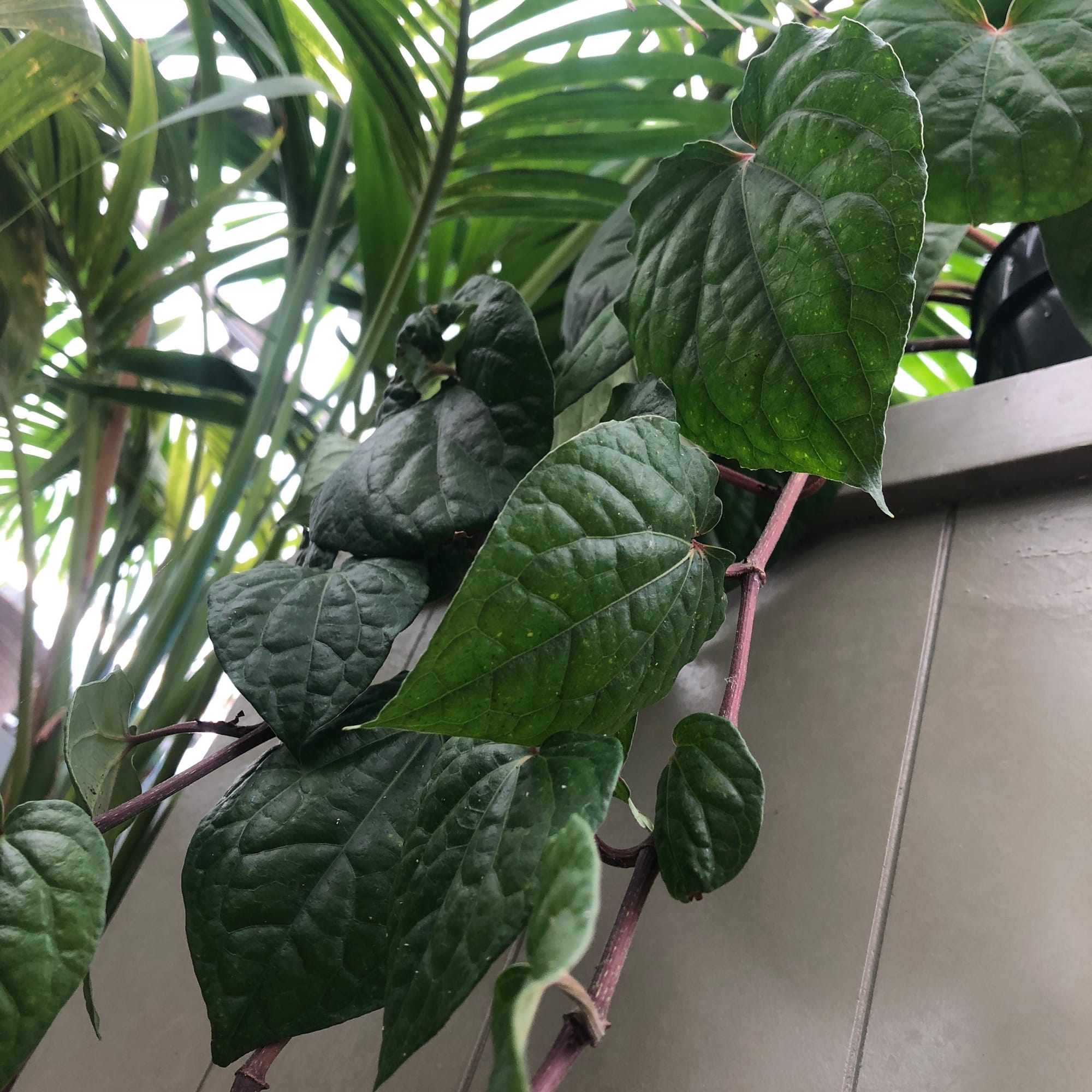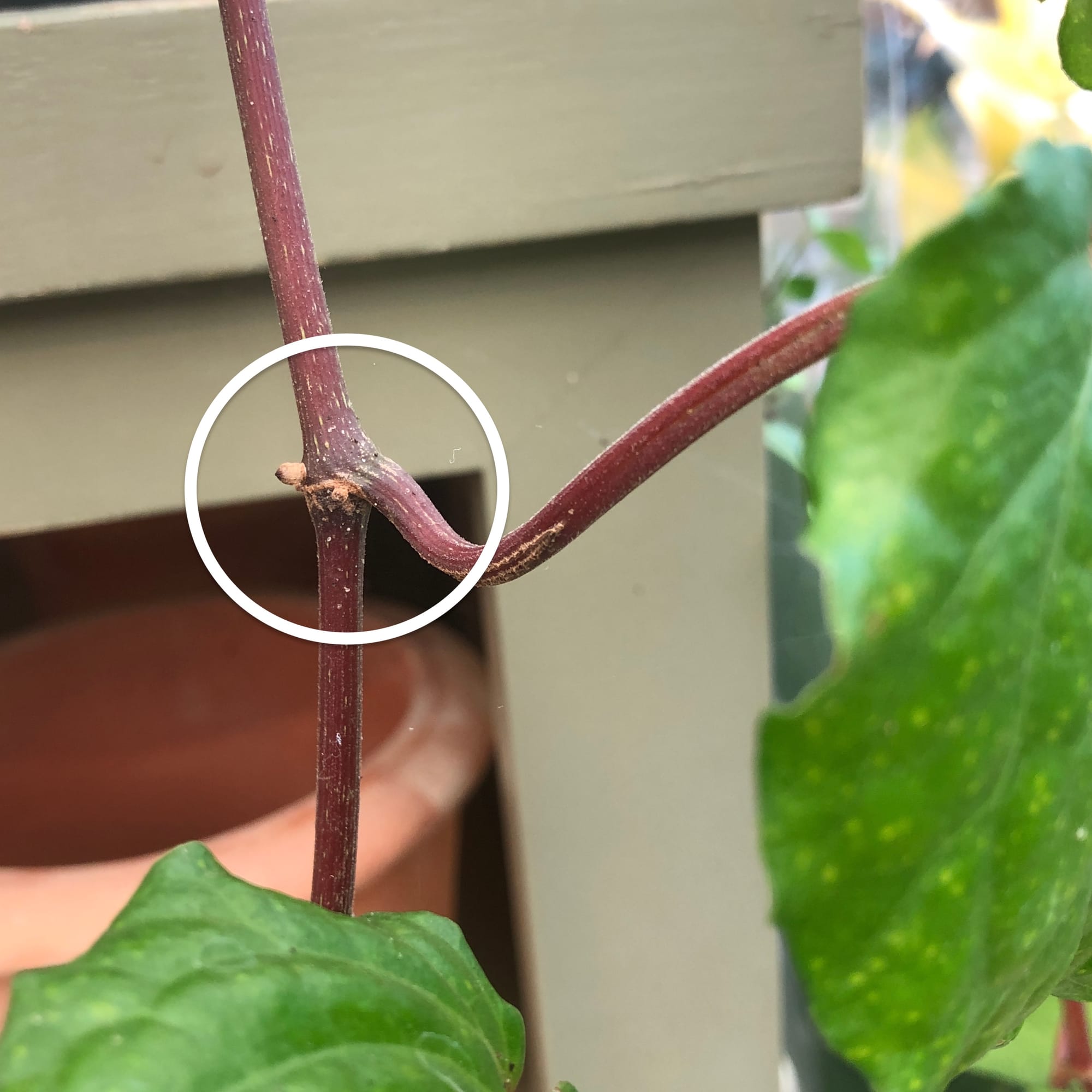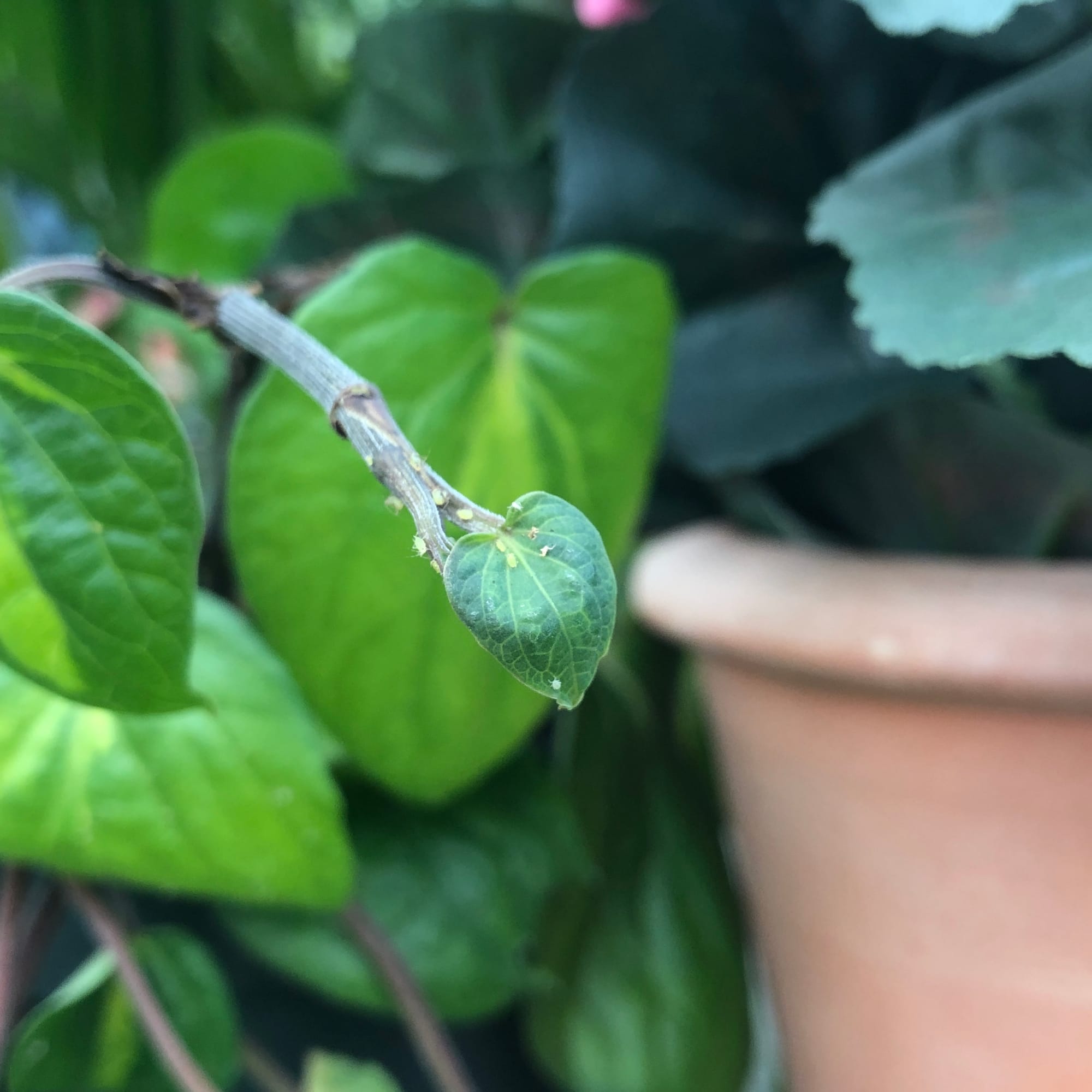
Piper methysticum 'Bright Eyes'
Contents
- Top Tips
- Location, Water, Humidity & Fertilisation
- Common Issues
- Origins, Temperature, Propagation, Repotting & Toxicity.
Need the answer to a specific plant query? Book a 1-to-1 video call with THE HOUSEPLANT DOCTOR™, the website's friendly author, to overcome and address your niggling problem! Available on iMessage, WhatsApp, Facebook Messenger & more.
Top Tips & Info
- Care Difficulty - Easy to Moderate
- Indoor Piper 'Bright Eyes' are best kept in a location that offers bright, indirect light without the risk of harsh sun. We recommend placing yours within two metres of a window for ultimate growth.
- Maintain evenly moist soil, allowing the top third to dry out in between waters. From mid-autumn until the late winter, be sure to keep your Piper plant on the drier side to replicate its much-needed dormancy period.
- We recommend feeding this plant every third of fourth water in the spring and summer, whilst reducing this to every fifth in the colder months. Fertilise using a 'Houseplant' labelled feed if possible, as this will include a good amount of Nitrogen for strong, healthy leaves.
- Repot every three years during the spring or summer, using a 'Houseplant' labelled potting mix and the next sized pot with drainage holes.
- Keep an eye out for Spider Mites that'll form webs in the plant's cubbyholes and leaves, as well as for Aphids on the juvenile (new) growth. Scroll down to the final image to find out more.
Location & Light - 🔸🔸
A location with a good angle to the natural light will be best at promoting vigorous, healthy growth. We'd recommend keeping yours within two metres of an east or west-facing window, or within one metre of a north-facing one. Due to the risk of sun-scorch in sun-filled rooms, keep an eye on drying soil and bleached leaves or try relocating it to a less intense area of the home.
Water - 🔸🔸
Maintain evenly moist soil, allowing the compost's top third to dry out in between waters. It's important not to promote what's known as 'irrigation abuse', whereby the specimen is subjected to periods of droughts, followed by floods of water. Not only will this promote unreliable foliar growth, but the risk of terminally damaged tissue below the soil line could also cause incompetent, functionless roots. Create a watering-rota if you're one for forgetful gardening! Under-watering symptoms include a shrivelled stem, yellowing leaves, little to no growth and dry, crispy patches forming on the leaf edges. These issues are typically caused by too much light/heat or forgetfulness. Remember, the brighter the location, the more watering you'll need to do. Over-watering symptoms include a weakened or rotten stem, no new growth, yellowing lower leaves and eventual plant death. Click here to learn more about root rot and how to address it!
Humidity - 🔸🔸🔸
Average room humidity is more than enough to satisfy this plant. Never situate it within a few metres of an operating radiator due to the heightened chance of browning leaf-tips. Gently hose the foliage down once a month to hydrate the leaves and keep the dust levels down. This will also replicate the act of rain penetrating its foliage - something that will only benefit your plant's overall health.
Fertilisation - 🔸🔸
Feed every four waters during the growing period and every six in the autumn and winter, using a 'Houseplant' labelled fertiliser. Never apply a 'Ready to Use’ product into the soil without a pre-water first, as it may burn the roots and lead to yellowed leaves.
If the foliage is showing signs of dullness or leaf-spots, be sure to increase fertilisations to give the plant a 'pick-me-up' with additional energy.

Piper 'Bright Eyes' can be propagated easily by stem/vine cuttings. To do so, simply cut the main stem one inch (2cm) above and below the node (circled above), and place in lukewarm tap water. You can then place the cutting into moist 'Houseplant' labelled potting mix once the roots are at least two inches (5cm).
Common Issues with Piper 'Bright Eyes'
Yellowing older leaves could be a sign of over-watering, but equally is a byproduct of maturity. If the older leaves rapidly become yellow in quick succession, over-watering could be to blame. People don't realise that a plant's root system needs access to oxygen too; when soil is watered, the air will travel upwards and out of the potting mix. A lack of accessible oxygen for the roots will cause them to subsequently break down over the oncoming days. Click on this link to learn more about root rot and how to address it.
Small flies hovering around your plant or soil is entirely natural and may just indicate you're watering a little too often. Fungus Gnats are a common 'pest' with Piper 'Bright Eyes' due to its dependency to reliable soil moisture, but won't pose any risk to the plant's health. Simply replace the top quarter of the plant's potting mix for a fresh batch of 'Houseplant' labelled compost, typical found at most garden centres. Remember to reduce the frequency of waters to avoid this occurring again!
If your specimen is located in a dark environment with mould developing on the compost's top layer, use a chopstick to stab the soil in various areas gently. You should aim to enter the compost between the base of the plant and the pot's edge, as failure to do so may lead to damaging its lower portion. Leave the holes open for a few days before re-surfacing the soil to avoid it becoming overly dry. Not only will the gentle shift in the soil's structure mimic the work of small invertebrates in the wild (worms, etc.), but it'll also add oxygen back into the soil, thus reducing the risk of root rot. Repeat this monthly, or whenever you feel the potting-mix isn't drying out quickly enough.
Curled leaves and brown leaf-edges are the result of too little water and over-exposure to the sun. Piper 'Bright Eyes' are best located in bright, indirect settings, and those that haven't acclimatised to the harsh rays will show signs of sun-scorch and environmental shock. A splash of winter sunlight is acceptable as long as the soil moisture is regularly observed, with complete avoidance once summer comes along.
Never situate it within four metres of an operating heat source, for instance, a heater or fireplace. Due to the heightened temperature, the plant will soak up far more moisture than those situated in cooler locations, increasing the chance of droughts and browning leaf-edges.
Origins
Piper methysticum was formally described by German botanist, Johann Georg Adam Forster, in 1786, during a worldwide expedition to document local animal and plant species. He used the Modern Latin word for 'drunkenness' or 'drunkard', in reference to the intoxicating outcome of drinking the South Pacific island drink, Kava - based off the roots. The plant also has medicinal and anaesthetic properties, too, and can be found on the islands of Vanuatu & Santa Cruz.
 The Distribution of Piper methysticum.
The Distribution of Piper methysticum.
Temperature
16° - 27℃ (61° - 80℉)
H1b (Hardiness Zone 12) - Can be grown outdoors during the spring and summer in a sheltered location whilst nighttime temperatures are above 16℃ (61℉), but is fine to remain indoors, too. If you decide to bring this plant outdoors, don't allow it to endure more than an hour of direct sunlight a day as it may result in sun-scorch. Regularly keep an eye out for pests, especially Aphids, when re-introducing it back indoors.
Spread
The total vine length can be up to 3m (9-10ft), with the overall width depending on the pot that it grows in. The ultimate size will take between 4 - 6 years to achieve when repotted biannually, with several new leaves unfurling per annum.
Pruning & Maintenance
Remove yellow or dying leaves, and plant debris to encourage better-growing conditions. While pruning, always use clean scissors or shears to reduce the chance of bacterial and fungal diseases. Never cut through yellowed tissue as this may cause further damage in the likes of diseases or bacterial infections. Remember to make clean incisions as too-damaged wounds may shock the plant, causing weakened growth and a decline in health. Pruning can double up as stem cuttings too, so keep reading to find out more on successful propagation!
Propagation
Via Seed or Stem & Eye Cuttings.
Stem & Eye Cuttings (Moderate) - Choose the healthiest, most established stems that are slightly hardened, yet still juvenile enough to bend slightly. Each cutting should only have two nodes with a leaf on the younger node - the older is for root development that'll be submerged in the soil. Cut directly below a node using a clean pair of scissors to reduce bacteria count. Situate the lower node into moist 'Houseplant' labelled compost, with only the leaf and the upper node sticking out of the soil. Blackleg can occur when the base becomes infected, typically caused by water-logging or a too-damaged wound. You can even place the cutting straight into lukewarm water to root, similarly to a Cheese Plant cutting. Simply place it into a moist bed of 'Houseplant' soil once there are at least two inches (5cm) of root growth.
Maintain bright light and evenly moist soil with the avoidance of direct sunlight or cold draughts, while following the same care routines mentioned in the article's top half. This method will take up to three months, so patience and the correct environment are paramount for success!
Flowers
Piper 'Bright Eyes' are uncommon to flower indoors due to the unfavourable growing conditions found in the typical home. This species is fact dioecious, meaning that a plant will either hold male or female sexual organs but never both, unlike most other houseplants. It is also far more likely for a male specimen to flower in the wild than a female!
Repotting
Repot every three years in spring using a 'Houseplant' labelled potting mix and the next sized pot with adequate drainage. This species is far better potbound for several years due to the heightened risk of root rot and repotting-issues (like transplant shock) - so only repot if you feel it's wholly necessary.
Hydrate the plant 24hrs before tinkering with the roots to prevent the risk of transplant shock. For those situated in a darker location, introduce extra amounts of perlite and grit into the lower portion of the new soil to downplay over-watering risks. Click here for a detailed step-by-step guide on transplantation, or via this link to learn about repotting with root rot.
Book a 1-to-1 video call with Joe Bagley if you'd like a personal guide to repotting your houseplant. This will include recommending the right branded-compost and pot size, followed by a live video call whilst you transplant the specimen for step-by-step guidance and answer any further questions!
Pests & Diseases
Keep an eye out for mealybugs, aphids & greenfly, spider mites, scale, thrips & whitefly. Common diseases associated with this species are root rot, red leaf-spot, heart rot, botrytis & southern blight - click here to learn more about these issues.

Mealybugs, Spider Mites and Aphids are the most likely culprits for a pest attack, with the latter shown in the image above.
Toxicity
Considered poisonous to pets when the leaves, stems or roots are consumed. If large quantities are eaten, it may result in vomiting, nausea and a loss of appetite.
Retail Locations
Rarely sold in garden centres, so have a look around on the internet for potential purchases.
Book a 1-to-1 Call with THE HOUSEPLANT DOCTOR™
If you need further advice with your houseplants, book an advice call with ukhouseplants' friendly and expert writer today! This can be done via a video or audio call on most apps, including Facebook, FaceTime & Skype. A ten-minute call costs £5.99 (US$7), or £15.99 for thirty minutes. You can ask multiple questions, including queries on plants, pests, terrariums, repotting advice and anything in between. Please consider supporting this service to keep ukhouseplants thriving!